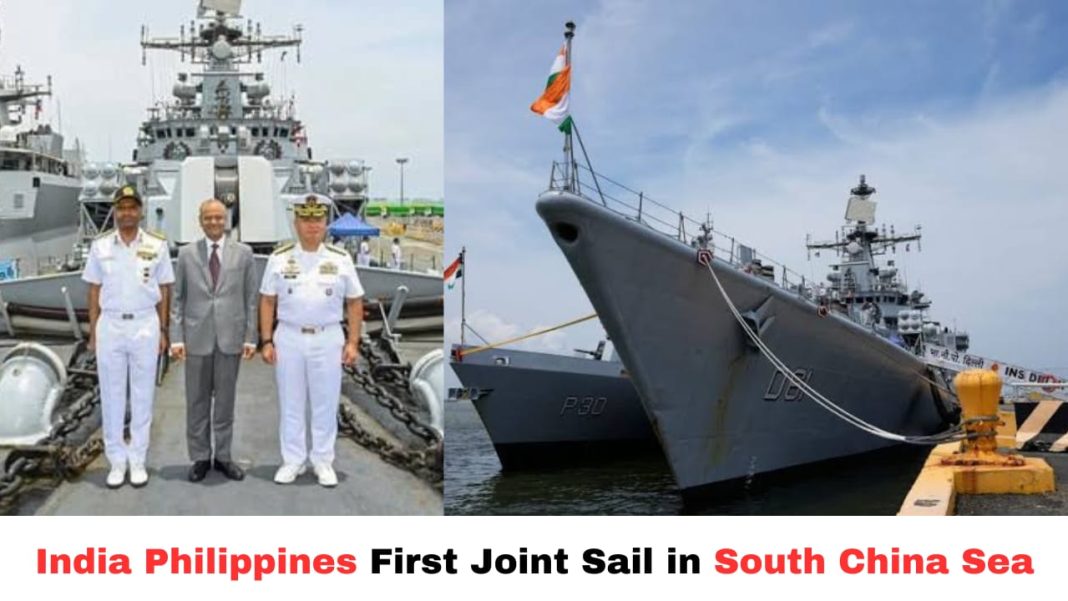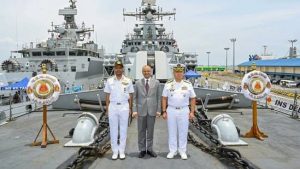Digital News Guru National Desk:
India–Philippines Launch First-Ever Joint Naval Patrol in West Philippine Sea: Strategic Statement to Beijing
India and the Philippines concluded their first joint naval sail in the West Philippine Sea—a significant escalation in defence cooperation that underscores both nations’ shared strategic concerns over Chinese maritime claims.
First-Ever Two-Day Joint Sail
On Sunday, August 3, and continuing into Monday, August 4, the Indian and Philippine navies conducted a bilateral maritime cooperative activity (MCA) inside the Philippines’ Exclusive Economic Zone in the South China Sea, known locally as the West Philippine Sea. Philippine Armed Forces Chief Gen. Romeo Brawner Jr. confirmed the operation was underway as President Ferdinand Marcos Jr. departed Manila for a state visit to New Delhi. The Indian flotilla remained in Philippine waters during his departure day.

Ships, Assets & Operational Focus
The Indian Navy deployed three eastern fleet vessels—INS Delhi (guided‑missile destroyer), INS Shakti (fleet tanker), and INS Kiltan (anti‑submarine corvette)—which arrived in Manila on July 30–31 for port calls prior to the exercise. The Philippines contributed two BRP frigates, Miguel Malvar and Jose Rizal, which joined the Indian vessels at sea. Activities focused on replenishment-at-sea, formation sailing, and tactical manoeuvring, underlining interoperability over combat drills.
Diplomacy at Sea: Marcos Visits India
The operation paralleled President Marcos Jr.’s five-day state visit to India (August 4–8), his first since assuming office. Besides shaking hands with Prime Minister Modi and President Murmu, Marcos is expected to seal agreements on defense procurement, pharmaceutical cooperation, and trade, anchoring maritime security cooperation in broader bilateral ties.
Messaging: Rule-Based Order & Mutual Resolve
Gen. Brawner emphasized the operation’s symbolic heft:
“We did not experience any untoward incidents, but … there are still those shadowing us—as we had already expected,”
“The presence of INS Shakti … sends a powerful signal of solidarity, strength in partnership, and the energy of cooperation between two vibrant democracies in the Indo‑Pacific.”
Both sides reaffirmed their commitment to uphold UNCLOS and the 2016 arbitration ruling that invalidated China’s “nine‑dash line” claims.

A Broader Strategy: MCA Since 2023 & Quad Expansion
Manila has been conducting maritime cooperative activities with several partners—including the U.S., Japan, Australia, France, and Canada—since late 2023. Its “transparency initiative” and open integration with the informal “Quad” security grouping reflect a concerted shift toward aligning with like‑minded democracies. Philippine leaders are now reportedly exploring permanent inclusion of India and South Korea in the Quad framework.
India’s Rising Foothold in Southeast Asia
The joint sail marks a deeper operational shift from New Delhi’s approach under its Act East and SAGAR (Security and Growth for All in the Region) doctrines. India has made multiple port calls to Manila since 2018 and signed memorandums with the Philippine Coast Guard on white shipping data exchange and maritime domain awareness. Meanwhile, the export of BrahMos supersonic missiles to the Philippines in 2022 and plans for Akash SAM systems signal a new level of defence interdependence.
Beijing’s Reaction & Regional Implications
China’s Foreign Ministry reiterated that South China Sea disputes should be handled exclusively by littoral states, rejecting third‑party involvement. Beijing described Manila’s actions as provocations and warned of resolute countermeasures. While no confrontations occurred, Philippine officials confirmed their ships had been continuously shadowed by Chinese naval or coast guard vessels—a now‑routine pattern in multilateral patrols.
Long-Term Significance & What Lies Ahead
The successful execution of this first MCA conveys several message-laden shifts:
- Multilateral deterrence: Manila and New Delhi are beginning to operationalise a deterrence architecture beyond bilateral port visits.
- Operational trust: Replenishment and communication drills lay groundwork for broader force integration and future crisis response.
- Non-wedge diplomacy: By anchoring the sail within the Philippines’ EEZ and under the rubric of fencing collective security (rather than aggression), both nations step around escalatory triggers.
Expect future collaboration to expand into intelligence sharing (e.g. white-shipping data), regional search-and-rescue drills, and joint planning under an evolving bilateral defense roadmap.
Conclusion
August’s joint drill marks a milestone in India-Philippines maritime cooperation and a clear strategic signal—anchored in legal norms, democratic alignment, and regional deterrence posture. It showcases how middle powers in the Indo‑Pacific can apply calibrated maritime diplomacy to safeguard sovereignty, strengthen interoperability, and offer a visible counter-narrative to unilateral coastal assertiveness.
The joint activity is not just about ships in motion—it reflects a deeper shift in India’s maritime outreach, the Philippines’ realignment, and the evolving contours of Indo‑Pacific security architecture.
You May Also Read: Arvi Bahal Flies to Space on Blue Origin NS-34 at 80









